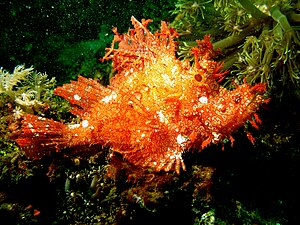Tentacle scorpionfish
| Tentacle scorpionfish | ||||||||||||
|---|---|---|---|---|---|---|---|---|---|---|---|---|

Tentacle scorpionfish ( Rhinopias frondosa ) |
||||||||||||
| Systematics | ||||||||||||
|
||||||||||||
| Scientific name | ||||||||||||
| Rhinopias frondosa | ||||||||||||
| ( Günther , 1892) |
The tentacle scorpionfish ( Rhinopias frondosa ) is a marine scorpion fish in the genus of the fringed scorpionfish . It colonizes the western Indo-Pacific, and lives there camouflaged in coral reefs . The species lives at very shallow depths, has poisonous spines and feeds on small marine animals.
features
Tentacle scorpionfish reach a maximum length of 23 cm. The body is stocky and covered with round scales. The body shape and color can adapt to the habitat. A wide variety of colors are possible from dark red to purple and from purple to yellow. Because of its variability, the tentacle scorpionfish is often confused with related species. Tentacle scorpionfish usually have 16 pectoral fin rays , 3 anal fin rays and 12 hard rays in the dorsal fin . The anterior spaces of the dorsal fin rays are fleshier than those of the posterior. The dorsal fin spines are relatively soft and pliable. The ventral, anal, dorsal and caudal fins are slightly or not at all notched. In adult specimens, the rows of caudal fins separate into four ends. The hard rays of the dorsal, anal and pelvic fins are provided with poison glands. Tentacle scorpionfish differ from the closely related species Rhinopias aphanes and Rhinopias eschmeyeri in several details. Fleshy tentacles above the eyes, 9 to 24 tentacles on the underside of the lower jaw. 2 to 4 backward-pointing tentacles under the eyes and several tentacles spread over the body. You can clearly see 1 to 2 black spots on the soft dorsal fin and several rimmed round spots on the head and body.
Occurrence
The natural habitat of the tentacle scorpionfish is in the Indo-Pacific . It extends from South Africa over the coastal areas of the Indian Ocean to the south of Japan and east to Australia . Occasionally the species has also been spotted off Hawaii . The tentacle scorpionfish prefers coral reefs with sandy or rubble-like subsoil that are located at a depth of no more than 30 meters.
Way of life
The tentacle scorpionfish follows a stationary approach to hunting. His appearance serves as a perfect camouflage and enables him to remain undetected on the ground and ambush potential prey. In this waiting position, tentacle scorpionfish can remain almost immobile for very long periods of time and then strike at lightning speed (within 15 milliseconds) when prey animals approach their mouths .
The lightning-fast opening of the jaws creates a negative pressure with which the prey is sucked in. The diet includes shellfish , cephalopods and small fish .
Locomotion
The locomotion of the tentacle scorpionfish is very different from that of other fish. Despite their fins , they rarely use them for swimming, instead they move crawling on the ocean floor .
toxicity
The first 12 to 15 rays of the dorsal fin, the first two rays of the ventral fin and three rays of the anal fin are poisonous . The fin rays have a poisonous furrow on the left and right on the front side, which contains a poison gland which is covered by skin. This skin tears open when stung, and the poison can be released as a result. Punctures from the tentacle scorpionfish cause severe pain, which can often last for several days. The poison consists of large molecular proteins that cause nausea, sweats, pallor. May cause palpitations and a general feeling of weakness. However, no deaths are known to date.
literature
- Ellen Thaler : Fringed Scorpionfish ( Rhinopias ). In: Coral. Marine aquarium specialist magazine, No. 62, April / May 2010, Natur und Tier Verlag, Münster, ISSN 1439-779X .
- Matthias Bergbauer, Robert F. Myers, Manuela Kirschner: The cosmos handbook dangerous marine animals. Kosmos, Stuttgart 2008, ISBN 978-3-440-10945-8 .
- Robert A. Patzner, Hans A. Baensch : Mergus sea water atlas. Volume 6: Non-Perciformes (non-perch-like) as well as butterfly and angelfish. Mergus-Verlag, Melle 1999, ISBN 3-88244-116-X .
- Hiroyuki Motomura, Jeffrey W. Johnson: Validity of the Poorly Known Scorpionfish, Rhinopias Eschmeyeri, with Redescriptions of R. Frondosa and R. aphanes (Scorpaeniformes: Scorpaenidae). In: Copeia. 3/2006, pp. 500-515.
- R. frondosa when "hunting" on: youtube.com
Web links
- Rhinopias frondosa on Fishbase.org (English)
Individual evidence
- ^ William N. Eschmeyer: Scorpaenidae . In: Margaret Mary Smith, Phillip C. Heemstra (Eds.): Smiths' Sea Fishes . Springer-Verlag, Berlin 1986, ISBN 978-0-387-16851-7 , pp. 463-478 .
- ↑ Hiroyuki Motomura, Jeffrey W. Johnson: Validity of the Poorly Known Scorpionfish, Rhinopias Eschmeyeri, with Redescriptions of R. Frondosa and R. aphanes (Scorpaeniformes: Scorpaenidae) . In: Copeia . No. 3 , 2006, p. 500-515 .
- ↑ Tentacle Scorpionfish on Fishbase.org , accessed January 18, 2013.
- ↑ starfish.ch accessed on January 16, 2013.
- ↑ fishchannel.com accessed on January 16, 2013.
- ^ A b Joseph S. Nelson : Fishes of the World . John Wiley & Sons, 2006.
- ↑ D. Mebs: Poisonous animals and their weapons . 2., rework. u. exp. Edition. Wissenschaftliche Verlagsgesellschaft, 2000, ISBN 3-8047-1639-3 .